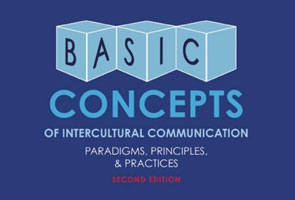Basic Concepts of Intercultural Communication:
Chapter Outline
PART I: Contemporary Text
1) Framing Intercultural Communication
- a) Introduction
- i) Why Intercultural Communication Matters
- ii) Overview and relationship to Basic Concepts of Intercultural Communication:Selected Readings
- b) Definitions & Scope
i) Objective and Subjective culture ii) Terminology
iii) Levels of analysis
iv) Levels of abstraction
c) Conceptual Focus
i) Constructivist communication ii) Embodiedexperience
2) A Paradigmatic History
- a) Positivism and the Hierarchy of Civilization
- i) Newtonian paradigm (1) Newton’s physics (2) Comte’s positivism (3) Social Darwinism
- ii) Implications of positivism for intercultural theory (1) Culture is epiphenomenal
(2) Culture is reified
(3) Culture is personalized - iii) Implications of positivism for intercultural practice (1) Area studies
(2) Do’s & don’ts
(3) Behaviorist learning
- b) Relativism and Cultural Systems
- i) Einsteinian paradigm(1) Systems theory(2) Post-modernism
- ii) Implications of relativism for intercultural theory(1) Cultural relativity
(2) Linguistic relativism
(3) The “silent language” of intercultural communication - iii) Implications of relativism for intercultural practice (1) Creating awareness of perspective
(2) Paradigmatic confusion
c) Constructivism and Intercultural Adaptation
- i) Quantum paradigm(1) Observer/observed interaction(2) Radical constructivism
- ii) Implications of constructivism for intercultural theory(1) Dynamic worldview(2) Embodiment
- iii) Implications for constructivism for intercultural practice(1) Self-reflexivity
(2) Intercultural empathy
- 3) Cultural Context and Interaction
- a) Contextual awareness
- i) Boundary conditions of culture
- ii) Generalizations and stereotypes
iii) Cultural self-awareness & identity
- b) Interaction analysis
- i) Language use
- ii) Nonverbal communication behavior
- iii) Communication style
- iv) Perceptual/cognitive style
- v) Cultural assumptions and values
- a) Contextual awareness
- 4) Intercultural Adaptation
- a) Developing intercultural sensitivity
- i) The ethnocentric positions(1) Denial
(2) Defense
(3) Minimization - ii) Theethnorelativepositions (1) Acceptance
(2) Adaptation
(3) Integration
- i) The ethnocentric positions(1) Denial
- b) Resolving developmental issues
(1) Recognizing simple diversity
(2) Establishing common humanity
(3) Generating self-awareness; resolving unity & diversity (4) Moving to contextual ethicality
(5) Resolving adaptation to difference & authenticity
(6) Resolving integration of difference & integrity
- a) Developing intercultural sensitivity
- 5) Intercultural Practices
a) International/Multicultural Education
- i) The value of intercultural communication in higher education
- ii) Linking intercultural communication to traditional liberal arts education(1) The emphasis on multiple disciplinary perspectives
(2) The emphasis on critical thinking
(3) The emphasis on ethical action
- b) International Exchange and Study Abroad
- i) Turning cross-cultural contact into intercultural learning (1) Strengths and limits of contact
(2) Intercultural learning - ii) Measuring intercultural learning
- iii) Intercultural education(1) Resolving Denial and Defense in pre-departure programs (2) Moving beyond Minimization in study abroad
(3) Fostering Acceptance and Adaptation on-site
(4) Using re-entry programming to establish Integration
- i) Turning cross-cultural contact into intercultural learning (1) Strengths and limits of contact
- c) Global business management/leadership
- i) The intercultural mindset(1) Investing in intercultural communication(2) Everywhere is Rome
- ii) Theinterculturalskillset(1) Focus on worldview experience
(2) Using cultural generalizations, avoiding cultural stereotypes (3) Leveraging learning with culture-general frameworks
(4) Creating strategies for mutual adaptation - iii) Developing intercultural sensitivity (1) The disinterest of Denial
(2) The destructiveness of Defense (3) The small world of Minimization (4) Self-referential Acceptance(5) Perspective-taking in Adaptation(6) Creative Integration - iv) Conclusion
PART II: Classic Readings
- Whorf, Science & Linguistics (10pp)
- Hall, Hidden Differences (14pp)
- Singer, Perceptual Approach (12pp)
- Stewart, Cultural Values (15pp)
- Barnlund, Global Village (16pp)
- Barna, Stumbling Blocks (16pp)
- Bennett, Empathy/Sympathy (23pp)
- Adler, Cultural Identity (20pp)
Basic Concepts of Intercultural Communication:
Paradigms, Principles, & Practice
Chapter Outline
Milton J. Bennett, Ph.D.

